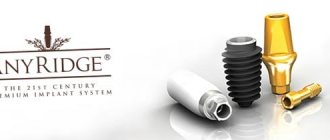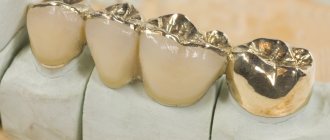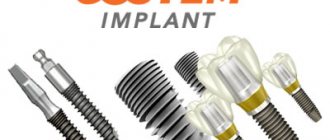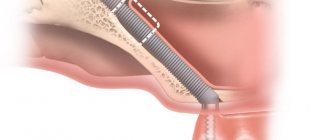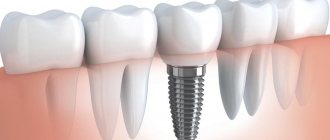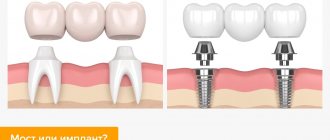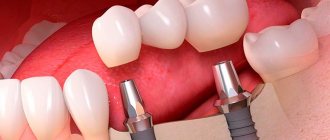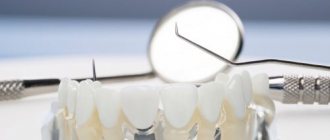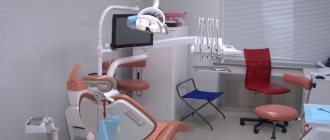The absence of 2 teeth in a row is a common defect that often occurs in patients. The problem needs to be eliminated, because the bone will atrophy, and over time it will be more difficult to solve it. Implantation is considered the best way to restore several teeth in a row, since it is the installation of durable artificial roots that will last a lifetime. On top they are covered with crowns, which completely preserve the function of chewing and recreate the aesthetics of a smile. The choice of implantation method depends on how long ago the teeth were removed and the structural features of the patient’s jaw.
Is it possible to implant 2 teeth at once?
Implanting 2 teeth is no different from restoring one tooth. Artificial roots are also placed, which are then covered with crowns. It is better to install both units at once, without dividing them by time. This will reduce the preparation time, there will be no repeated anesthesia and double antibiotic therapy, which is undesirable to carry out more than once every six months.
Implantation is usually performed using the classical method:
- Installation of an artificial root and prosthetics are separated by 2-6 months, which are needed for the implants to heal.
- First, an implant is placed, the gum is sutured, and fusion occurs with the bone tissue.
- After 2-6 months, the gum is cut, an abutment is placed, and the implant is covered with a crown.
During osseointegration, a removable temporary butterfly immediate prosthesis is worn.
Stages of treatment
1. Consultation
Examination, questioning, selection of treatment protocol.
2. Diagnostics and preparation
Comprehensive examination (orthopantomogram, CT), testing. Treatment of teeth and gums (if necessary), hygienic cleaning, 3D planning of surgery.
3. Implant installation
Carried out in accordance with the selected protocol. In a two-stage procedure, titanium roots are implanted using a patchwork method; in a one-stage procedure, titanium roots are implanted through a micropuncture of the gum or into the socket of an extracted tooth.
4. Prosthetics
Delayed loading with a prosthesis during classical implantation (a permanent orthopedic system is installed on artificial roots after they have completely engrafted). Immediate loading with a one-stage method (on days 1-3, adaptation crowns or a prosthesis made from the patient’s casts are installed on the abutments. After 10-12 months, re-prosthetics are performed with a permanent structure).
The one-step protocol includes one more stage - surgical removal of the affected tooth or root.
Implantation of two teeth side by side
Depending on the location of two missing teeth in a row, the requirements for implants and crowns differ.
Front teeth
When installing implants in the frontal area, there are features:
- increased demands are placed on aesthetics;
- Individual zirconium abutments are used;
- if necessary, gum plastic surgery is performed;
- narrow implants are installed for a narrow frontal area;
- before the implants heal, temporary or lightweight crowns or butterfly prostheses are placed, which are attached to adjacent teeth;
- After engraftment, metal-free zirconium dioxide crowns are installed with the color most closely matched to the shade of adjacent teeth.
Chewing teeth
If there are no two teeth in a row in the lateral zone, thin short implants are not suitable for restoring such units. Wider ones are used so that they can cope with chewing loads. We use durable crowns; we install metal-free ones made of zirconium. Such prostheses last for 20 years and are fully compatible with the body. Immediate loading of the implant with crowns is not permissible, since artificial roots that have not taken root may move during chewing.
Treatment and implantation of two teeth
Attending doctor
Strigin Vladimir Igorevich
Find out the price
Question 5: Are there any age restrictions?
There are practically no age restrictions for dental implantation. Implants are allowed to be placed in young patients after the final formation of the dental system (about 18 – 20 years), and in adults, teeth can be implanted at 70 and 90 years.
If a child under 18 years of age needs to place an artificial pin instead of a molar, the dentist may suggest using a temporary implant and after a while placing a permanent one.
Is it possible to place one implant on two teeth?
This is impossible, since when installing one implant with two crowns, one of them will be suspended. This will create a natural lever that will eventually dislodge the artificial root from the bone. If the dental units are small and located close to each other, there is the option of installing two mini-implants. This way the load will be distributed evenly, but this option is temporary.
Theoretically, there are possible options that we do not practice:
- If there is no central and lateral incisor in the upper jaw, then you can place one implant in the center and hang a small lateral tooth on it. This will reduce the load.
- If there are no two incisors on the lower jaw, then you can make one implant and place 2 crowns with minimal load.
- You can install one implant and place a bridge supported by it and a living tooth. But this is strictly not recommended. Living teeth are mobile, and artificial roots are firmly attached to the bone - a shock-absorbing effect will occur, which will lead to loosening of the prosthesis, dislocation of one or both supports.
Question 6: How painful is the implant procedure?
The procedure itself does not cause pain or discomfort. The patient is first given anesthesia, which completely removes the pain. During the process of inserting a titanium pin, a person can watch a movie, listen to music or an audio book - he will not feel any discomfort.
Pain may be bothersome after the anesthesia wears off. But for this, the dentist prescribes painkillers to the patient to relieve pain and general discomfort. The pain should completely subside 3 to 5 days after installation of the implant. If it continues and is accompanied by swelling and fever, you should definitely consult your doctor.
Implantation for isolated absence of 2 teeth
1 implant is placed in each defect area. The choice of shape and size of the artificial root depends on the location on the jaw - in the anterior or frontal area.
Simultaneous installation of two separate roots is feasible if the patient still has the normal ability to eat:
- defects are located on one side of the jaw;
- on different jaws, but on the same side.
Otherwise, the operation is divided over time. For example, if two teeth are missing at the same time - one is upper left, the second is lower right.
For the chewing area
Thicker rods are installed in the lateral parts of the jaw, the size of which depends on the anatomy and the distance between the elements of the dentition. The classic two-stage technique is usually used. It is necessary that the implant can withstand serious loads during the process of chewing food. The shape and color of dentures or crowns are selected taking into account similar characteristics of a person’s natural teeth.
Today, a large number of implants for molars and premolars are available from different manufacturers.
Installation of implants in cases where two adjacent teeth are missing. A traditional 2-stage scheme or a one-stage protocol with immediate loading can be used.
Is it possible to install implants immediately after removing 2 teeth?
This method is possible. Single-stage implantation is used, in which the implant is placed immediately into the hole after tooth extraction. But the following conditions must be met:
- the procedure is planned in advance to allow for diagnostics and assessment of the operation;
- removal was carried out atraumatically, without damaging the alveolar process;
- there should be no inflammation, cysts, granulomas, purulent processes;
- the volume of bone tissue is sufficient for the implant to be securely fixed.
Doctor's advice - crowns can be placed immediately
For this purpose, a one-stage implantation method is used, when an implant is placed and covered with a crown on top, without waiting for its engraftment. The method is used when there is a sufficient amount of bone tissue. Used for dental units that do not actively participate in chewing. The crown is placed temporary, made of plastic or metal-plastic, and removed from the bite (lower in height) to eliminate active loads. After engraftment, it changes to permanent.
Levin Dmitry Valerievich
Chief physician, Ph.D.
When is bone augmentation needed?
For implantation to be carried out flawlessly, a sufficient amount of bone tissue is required. If teeth are missing for more than a year, then in 95% of cases bone grafting will be needed due to atrophy. Osteoplasty is needed so that the implant does not damage blood vessels, nerves, and recreates normal anatomy. The strength of root fixation also depends on it.
Our Center uses the following methods:
- Sinus lifting is a bone grafting procedure performed on the upper jaw in the area of the maxillary sinus. The mucous membrane is lifted, the vacated space is filled with bone chips. Often performed simultaneously with implantation.
- Guided bone regeneration - the gum is exfoliated, bone material is added, and covered with a membrane. Implants are installed at the same time if the bone deficiency is small. Recovery takes six months.
Implantation without bone grafting is possible when, along with implantation, the process of tissue growth begins. This technology is optimal; bone growth stimulators are fixed to the neck of the implant. The procedure is low-traumatic, but expensive. Its type - autotransplantation (transplantation of bone blocks from other parts of the human body) - is not used in the clinic, because the blocks can dissolve.
The sooner the tooth is restored, the less bone loss develops, so surgery to build it up may not be necessary.
Price
The clinic uses a case payment system. The cases are designed for installation of 1 implant. Accordingly, if two teeth are missing, the package cost will double.
The cost of the surgical stage includes:
- anesthesia;
- implant;
- plug, abutment, former;
- complex of reconstruction and basic bone augmentation;
- repeat CT.
The price of implants varies depending on the type of bone. Nobel Biocare PMC (cheaper) is intended for weak bones, and Nobel Biocare Conical Parallel CC (more expensive) is for dense bone tissue.
The cost of prosthetics includes:
- making a crown;
- taking impressions;
- installation.
Paid separately:
- tooth extraction with one-stage implantation - the price depends on the complexity (simple is cheaper, complex is more expensive);
- bone grafting or sinus lifting if necessary - the price depends on the amount of bone material and the method of osteoplasty.
Guarantees
Our Center uses implants with a lifetime guarantee - Nobel Biocare. We provide guarantees:
- 2 years for treatment;
- 1 year for prosthetics;
- lifetime for implantology.
Warranty obligations apply provided that the patient follows the doctor’s recommendations, rules of care and regularly visits the dentist. The warranty program includes a complex: for an implant, surgery, bone reconstruction and prosthetics.
Features of complete prosthetics
The clinics of the German Implantology Center in Moscow are a team of expert dentists who constantly improve their skills, participate in domestic and foreign symposiums, and introduce innovations. For more than 11 years of successful dental practice, we have been able to become a leader not only in Moscow, but also in Russia in the field of implantation and prosthetics.
Therefore, dental restoration in our clinics is as comfortable and painless for you as possible - safe anesthesia and sedation are used. The doctor tells you what symptoms may appear in the first days after surgery and prescribes medications appropriate to the case. The doctor is always in touch with the patient until complete healing.
Alternatives to implantation
- Dental bridge - structures in the form of welded crowns are placed in place of missing teeth. Along the edges they rest on supporting living teeth, the middle pendant teeth replace lost teeth. The method has disadvantages - grinding and depulping of supporting units, the process of bone atrophy continues, short service life in comparison with implants - up to 15 years.
- A removable denture is an artificial gum with plastic crowns. It is attached to adjacent teeth with hooks or to the gums using suction. Under such prostheses, bone atrophy progresses with greater force. In addition, it is uncomfortable for a person to chew, and long-term addiction occurs. Service life - up to 7 years.
